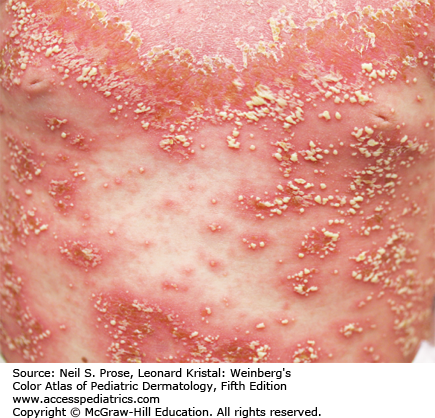Dermatology Question of the Week: Pediatric Problems

A 6-month-old boy is admitted with fevers, failure to thrive, and a generalized pustular eruption present since the neonatal period. The rash began as scattered pustules on an erythematous base and progressed to involve the entire body, including the scalp and flexures. A representative photograph is shown below.

There is no mucosal involvement. His parents report that he has had multiple admissions for sepsis-like episodes, although cultures have always been negative. Laboratory evaluation reveals leukocytosis, elevated inflammatory markers, and persistent hypocalcemia. A skin biopsy shows psoriasiform epidermal hyperplasia with subcorneal pustules composed of neutrophils.
Which of the following is the most likely diagnosis?
A. Infantile pustular psoriasis
B. Netherton syndrome
C. Omenn syndrome
D. DIRA (Deficiency of IL-1 Receptor Antagonist)
E. Severe congenital ichthyosis
Rationale:
This question evaluates the recognition of a rare autoinflammatory disease caused by mutations in the IL1RN gene, leading to unregulated IL-1 activity. The onset is typically early infancy with systemic inflammation, including fever and failure to thrive, presenting with pustular eruption, elevated inflammatory markers, and resembling pustular psoriasis histologically. It is typically refractory to standard immunosuppressants but responds dramatically to IL-1 blockade (e.g., anakinra, canakinumab).
Correct answer: D. DIRA (Deficiency of IL-1 Receptor Antagonist)
DIRA classic features include neonatal pustular eruption, systemic inflammation, sterile osteomyelitis, and hypocalcemia. Histopathology mimics psoriasis, but with severe systemic features and genetic confirmation.
Incorrect answer choices:
A. Infantile pustular psoriasis can have similar histology but is rare in neonates and doesn’t typically cause systemic symptoms like fevers or failure to thrive.
B. Netherton syndrome presents with erythroderma, ichthyosis linearis circumflexa, and hair shaft abnormalities (trichorrhexis invaginata).
C. Omenn syndrome is a severe combined immunodeficiency (SCID) variant with erythroderma, lymphadenopathy, hepatosplenomegaly, and eosinophilia. Biopsy typically shows interface dermatitis, not pustular changes.
E. Severe congenital ichthyosis includes conditions like lamellar ichthyosis or harlequin ichthyosis, which do not present with pustules or systemic inflammatory signs like fever or leukocytosis.
Additional reading at Fitzpatrick's Dermatology Chapter 39: Autoinflammatory Disorders

Create a Free MyAccess Profile
AccessMedicine Network is the place to keep up on new releases for the Access products, get short form didactic content, read up on practice impacting highlights, and watch video featuring authors of your favorite books in medicine. Create a MyAccess profile and follow our contributors to stay informed via email updates.